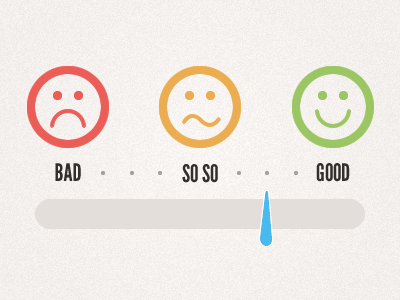- Resources
- How can Speech Analytics tell if my customer is happy or not?
How can Speech Analytics tell if my customer is happy or not?

At the beginning and end of every call, your Speech Analytics system displays customer mood on your Agents dashboard. How does a machine understand whether your customer is happy or not? It uses two things:
Natural Language Processing
Sentiment Analysis
Natural Language Processing.
Conventionally, people used programming languages to “speak” to computers. But now, we see Alexa, Siri and Cortana, following instructions we give in our “natural“ language. This is thanks to NLP. NLP or Natural Language Programming is the ability of a computer program to understand natural human language. It is an aspect of Artificial Intelligence.
Sentiment Analysis.
People don’t just communicate information using language. We communicate emotions too. Sentiment Analysis is a layer placed over Natural Language Programming, where a program is “trained” to understand sentiment in a text passage.
How does this work? The short explanation
Very simply speaking, your SA first translates your call recordings to text. It then scans for positive and negative words. It relates each word to the surrounding 5 words. Then it uses these words as context to understand word meanings. Like humans, machines to get better and better at understanding language through exposure and experience.
So the very short explanation would be: Your Speech Analytics system can tell if your customer is happy or not, because of experience.
The slightly longer explanation
What we mean by experience is that your Speech Analytics System has been exposed to billions and billions of words—until it’s learnt to understand meanings. This is similar to how a well trained, educated—and possibly middle aged— person gets good at understanding what others mean to say.
It learns to understand slang, humor and sarcasm.
For example,
It learns to differentiate this sentence: That is so sick!
From this sentence: I’m sick of you.
It also assigns intensities.
For example, in this sentence:
I am very unhappy with your service.
SA will consider this sentence negative because of the presence of unhappy. And then assign it an intensity of +2 due to the presence of very.
And then gives you an aggregate.
For example, in this sentence:
I am happy with your service but your product is too costly.
SA will be trained to assign costly as negative. It will add ++ for intensity. But then it will calculate for the positive emotions. Then, it will use appropriate aggregators— like sums or averages— to assign a final value to your sentiment.
How accurate is SA at analyzing sentiment?
SA is more accurate than humans.
BUT, this statement comes with two disclaimers.
Disclaimer 1: SA is only more accurate than humans over large quantities of data that have to be analyzed within tight deadlines. This is because humans get bored with repetitive tasks. Pressure to meet deadline, tiredness and boredom can affect human accuracy.
Disclaimer 2: SA is not 100% accurate. On an average, SA can be said to be is 60-85% accurate. But, know this—within the professional setup of gauging sentiment from text, humans are not 100% accurate either.
Certain sentences would provide hurdles to humans and machines.
For example, it has shown 10% growth.
Whether this sentence is positive or negative will depend on what “it “ is.
Humans weren’t designed for boring, repetitive work.
How can you improve your SA?
- 1. Training.
How was the service? Good.
An inexperienced person may think that good connotes positivity. But surveys have revealed that when talking about customer service, good mostly means mediocre. A trained professional or a Speech Analytics system specializing in customer care, will know this. Just like for humans, training is important for SA too.
- 2. Learning.
Language keeps evolving. Words change their meanings over time (see pic), slang gets added and deleted. Just like old people can get outdated and find it tough to follow teenager’s conversations, your SA needs to keep updating itself too.
That’s Nice
How the meaning of nice changed over the years?
1300: ignorant
1500: meticulous, attentive, sharp
18th century: something pleasant or agreeable
- New frontiers such as Voice.
Tech wizards are continuously trying to improve SA. Voice will be their next breakthrough. Their machines are being trained to recognize the subtlety of voice inflections. As they study pitch, inflections and silences between words—they will learn to understand voice directly. They’ll measure expressions in speech, that aren’t available in text. For example, if we go back to this sentence:
How was the service?
Good.
Though the implication of good isn’t easy to understand in text, voice inflections can help reveal how good the customer really thought your service was.
So finally, can you trust SA to accurately know your customer moods?
Yes.
Although, in face-to-face conversations with known people, humans are still far better than machines at judging emotions; SA is a more accurate tool for going through large data, and judging a huge number of conversations on a single, standardized scale.
As with all Artificial Intelligence tools, the aim is not to replace but to augment human performance.
Ozonetel’s Speech analytics solution has won the Frost & Sullivan New Product Innovation Award for 2022 for its unique ability to deliver audio speech analytics in real-time. Moreover, the award-winning solution is highly customizable, easy to deploy, and integrates seamlessly with most customer relationship management systems and social media applications.
In Frost & Sullivan words –
“To create a new speech analytics solution, a company needs to understand the market’s needs and deliver a solid solution designed and embedded with high quality and reliable performance. Ozonetel embodies this concept.”
To get a demo of how Ozonetel’s Speech Analytics works, Schedule a Demo with our experts today!







